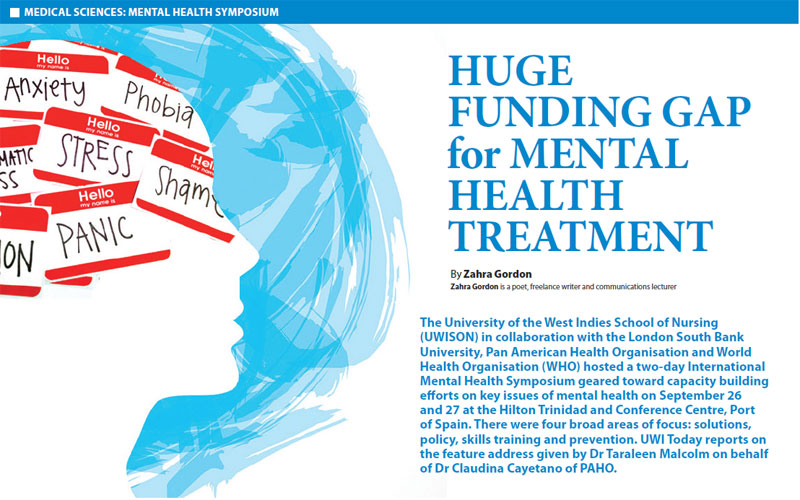
T&T is the only country in the Caribbean to establish guidelines for ethical reporting on suicide. In a region where mental health illness carries weighty stigma, the launch of these guidelines was progressive. Still, statistics gathered by the Pan American Health Organization (PAHO) show a significant gap in funding allocation for mental health locally.
Dr Taraleen Malcolm, T&T-based PAHO NCDs & Mental Health Advisor, shared these statistics at the International Mental Health Symposium “No Health Without Mental Health” hosted by the UWI School of Nursing on September 26 and 27.
Malcolm presented the day two keynote address, “Emerging Trends & Issues in Mental Health,” on behalf of Dr Claudina Cayetano, PAHO Regional Mental Health Advisor.
According to Malcolm, in T&T 3.7% of the total health budget is allocated to mental health. However, in Latin America & the Caribbean, mental health disorders account for 22.2% of the burden of disease. As Malcolm put it, the treatment gap is overwhelming and requires urgent attention.
Studies have shown a global disparity between treatment for physical disorders and treatment for mental health disorders. The disparity is even further exacerbated when countries are divided into high income and low and middle income categories, Malcolm explained. In high income and low & middle income countries, diseases like diabetes had 94% and 77% treatment rates respectively. Meanwhile, depression had treatment rates of 29% in high income countries and 8% in low & middle income countries.
Barriers to the provision of mental health treatment exist globally in both high income and poorer countries. So although T&T is a high income country, the healthcare sector still faces challenges such as insufficient financial and human resource allocation and the centralisation of services making mental health care inaccessible to patients.
The need to focus on community-centered mental health care services is key to closing the treatment gap. Malcolm noted that of the 3.7% of the T&T health budget spent on mental health, 94% goes to mental hospitals. The location of mental hospitals – which tend to be in urban areas – makes accessibility an issue, explained Malcolm.
“Financial resources and geographical locations limit access to services. You have situations where you have general hospitals that do not admit or treat people with mental health disorders and then you have poor accessibility at the primary care level that forces people to either not receive care at all, or access care at centralised psychiatric institutions,” she said. “We have been talking about community-based mental health services for years, but still two-thirds of all available beds are in mental hospitals.”
Other barriers to mental health care provision outlined by Malcolm were: the inability to integrate mental health into primary care services due to a lack of clinical supervision and understaffing; the lack of investment in tertiary psychiatric institutions; the tendency of people in leadership roles to lack public health training; and the lack of political will to advocate for better mental health services.
Mental health issues are often characterised as isolated, but Malcolm pointed out these issues affect all corners of society. “The burden and impact of mental health are large and widespread and can be felt at all levels. It can be felt at the individual level in terms of disability and premature mortality; at the societal level with the issues of discrimination in the community; and at the economic level which is the cost to the individual, the cost to the family and the cost to society.”
According to Malcolm, bridging the treatment gap is a case of striving to achieve universal access to heath care.
Suicide Prevention
The National Media Guideline for Responsible Reporting on Suicide was launched on September 10, World Suicide Prevention Day. The guidelines were developed by PAHO and adopted by the Ministry of Health. At present, media houses that implement the guideline will do so voluntarily. However, Malcolm said the Ministry and PAHO are working with the T&T Publishers and Broadcasters Association towards official incorporation into the code of conduct. “For now, we are hoping that people will recognize the importance of it and put it into practice,” she said.
Malcolm added that a trend of “copycat suicides” prompted the creation of ethical guidelines.
“It’s not that we’re telling the media not to report, but how should you report it? Is it the front page? The main headline? What should the headline be? We also included in that guideline a requirement to provide a message of hope and also contact information for hotlines so persons who are in that situation know what resources are available.”
The guidelines are just one strategy implemented by PAHO to provide tools for professionals. The organisation also launched a free, online course last month for primary health care providers, “Preventing self-harm/suicide.” The course, which is available in the Caribbean, teaches early detection techniques, behaviour management, identification of risk factors and includes modules on stigma and discrimination.
Another regional initiative supported by PAHO is the Intentional Self Harm Alert System in Belize. The alert system is part of the Belize computerised health information system, a national, electronic patient record system. Patients suspected of or with previous cases of self-harm are closely monitored through the system. According to Malcolm, this initiative presents a prime opportunity for South-to-South sharing between Belize and T&T. |





